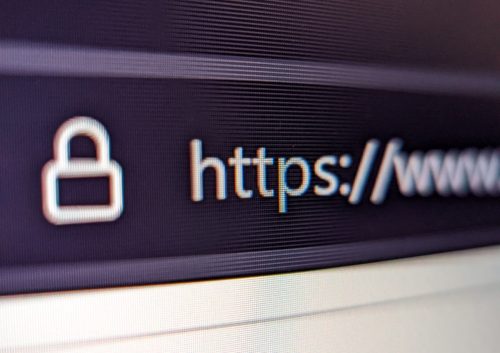How to Know If a Website Is a Scam: 11 Best Ways to Protect Yourself

We all know scammers use ploys such as fake emails, phone calls, and text messages to lure unsuspecting victims into giving up their personal information. But con artists also create fake websites to trick people, and it happens more than you think. Cyberattacks are on the rise, increasing by a staggering 72 percent since 2021—and last year alone, over 353 million people had their data compromised, according to The Identity Theft Research Center (ITRC) Annual Data Breach Report. With that in mind, it’s essential that you learn how to know if a website is a scam.
While cybercrime is alarming, there are ways to fight back and protect yourself from rampant thieves. Before you click on a site or respond to a shady message, read what tech experts told Best Life about identifying a website scam and ways to avoid online swindlers.
RELATED: 10 Cybersecurity Tips Everyone Needs to Know Now.
How to Spot Website Scams
Cyberattackers use sophisticated techniques to steal money and information, including setting up fake websites that look legit. Read on for 11 ways you can protect yourself online.
1
Find security icons.

Websites with security seals indicate their legitimacy and often offer additional information about the site when clicking on the stamp, such as domain validation or owner ownership.
“If this information is not displayed or if the page does not have recognizable security seals, it is likely a fraudulent website,” warns Franklin Orellana, DBA, program chair of Data Science at Post University.
2
Look for the lock.

If there’s a lock icon next to the URL, that’s another sign that the website is secure.
“This symbol represents an SSL/TLS certificate, guaranteeing data encryption and website authentication,” Orellana explains. “This is essential because when browsing the internet, it is necessary to exchange private information, so you must verify that this lock is present.”
RELATED: 7 Ways to Spot Fake Deals and Scams When Online Shopping.
3
Be wary of misspelled URLs.

A common way to find website scams is by subtle misspellings or incorrect domains (e.g., “.com” replaced with “.net”).
“We encourage consumers to look for security indicators since genuine websites often use HTTPS and display a padlock icon in the address bar,” says Daniel Shapiro, SVP of Brand Relationships & Strategic Partnerships at Red Points. “However, be aware that some sophisticated phishing sites may also use HTTPS.”
4
Make sure the site doesn’t come to you first.

Chris Olson, founder and CEO of The Media Trust, says, “A trustworthy website will not introduce itself to you—it will not pop up on your device when you weren’t expecting it to or prevent you from returning to your previous activity.”
5
Use a VPN or proxy server.

To safeguard yourself from online scammers, it’s a good idea to use a virtual private network (VPN) or proxy server to mask your IP address and encrypt your internet connection.
“This makes it harder for malicious websites to track your online behavior or target you with scams,” says Yuli Azarch, CEO of RapidSeedbox.com. “Some VPNs and proxies can also block access to known malicious sites, which provides an extra layer of protection.”
RELATED: How to Set Up a VPN to Stay Safe Online.
6
Use a strong password.

Stop making it easy for hackers by using searchable passwords that include your birthday and other accessible information.
“Using strong, unique passwords for each of your online accounts can stop a security breach on one site from affecting your information on another,” Azarch advises. “Password managers can help you generate and store complex passwords, reducing the risk of reuse and making it harder for hackers to gain access.”
7
Enable two-factor authentication.

Two-factor authentication can be a hassle but saves you a big headache by preventing hackers from getting your information.
“Two-factor authentication adds an extra layer of security by requiring not only a password, but also a second form of verification, such as a code sent to your phone,” Azarch explains. “This makes it much harder for scammers to access your accounts, even if they get your password.”
8
Double-check the domain name and URL.

If you suspect a website is fake, carefully look at the domain name and URL.
“Scammers often create URLs that are very similar to legitimate sites but with slight variations that can easily be overlooked, such as replacing an ‘o’ with a zero or using different top-level domains,” warns Rene Ymzon, an engineer and tech expert at Advance Motion Control.
By examining the URL before clicking on the site or entering your information, you can avoid a cyberattack.
RELATED: 5 Texts That Are Always Scams, Experts Warn.
9
Analyze the source of the website link.

Scammers often target people with links to sites that come from social media posts, unexpected emails, or comments that appear out of context. Analyzing the source of the website link can help you protect yourself.
“If you receive a link from a source you didn’t anticipate or through channels that seem untrustworthy, it’s a red flag,” Ymzon cautions. “Always verify the sender’s authenticity and consider whether it makes sense for you to receive such a link. This step is crucial because it helps you identify and avoid potentially harmful websites by questioning the legitimacy of the link’s origin.”
10
Ask yourself how you found the site.

If you’re about to click on an unknown site, Olson suggests stopping and asking yourself the following questions.
“Was it recommended by a friend, family member, or reliable institution (such as your bank, local government, or a business you frequent)? If you research the website, can you find good information from multiple sources?”
11
Look for real reviews.

The internet is full of fake reviews. It’s frustrating to sift through spam to find real ones, but Olson explains, “To find more reliable ones, search for the name of the website you are researching followed by ‘Reddit’ or the name of another popular discussion board.”
If the site doesn’t have reviews or information about it, avoid it—and don’t enter your credit card number, name, address, or any other personal details.